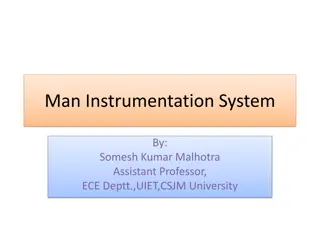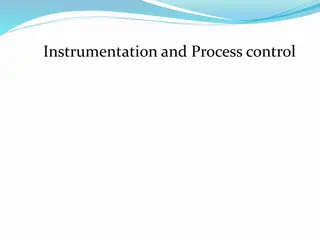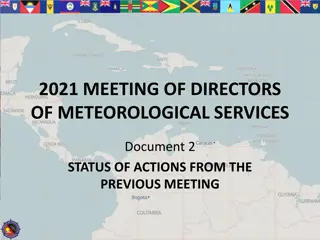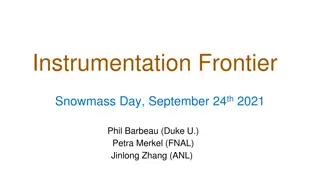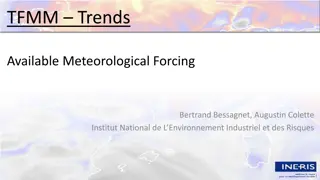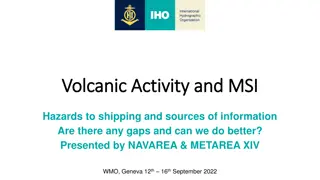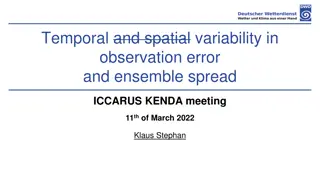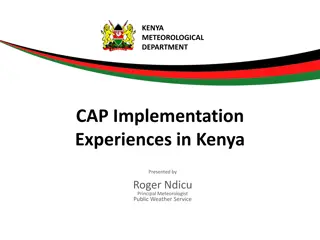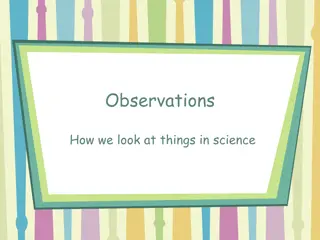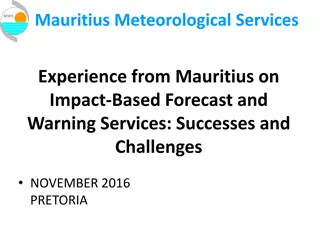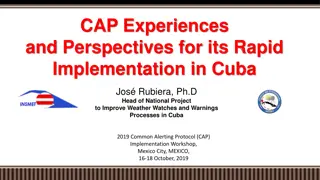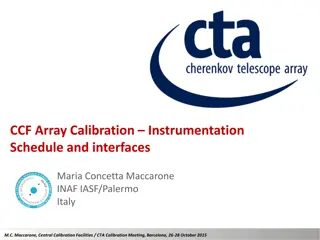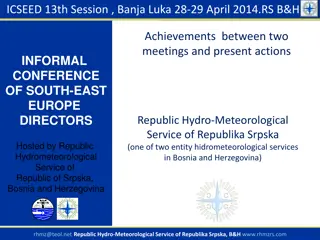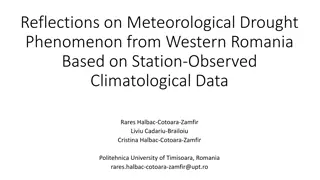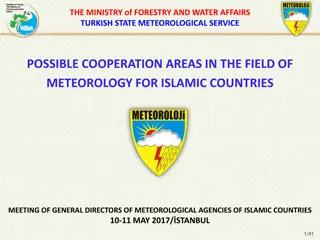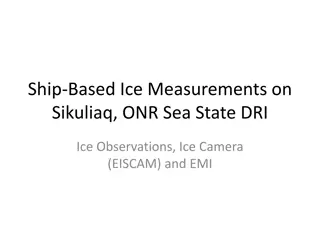Meteorological Instrumentation and Observations Overview
Overview of weather maps, symbols, and the weather station model used in meteorological instrumentation and observations. Explains the importance of weather charts in forecasting processes. Also introduces the FM System of Code Forms for reporting weather observations. Helpful resources for students studying atmospheric sciences.
Download Presentation

Please find below an Image/Link to download the presentation.
The content on the website is provided AS IS for your information and personal use only. It may not be sold, licensed, or shared on other websites without obtaining consent from the author. Download presentation by click this link. If you encounter any issues during the download, it is possible that the publisher has removed the file from their server.
E N D
Presentation Transcript
The Course of Meteorological Instrumentation and Observations MUSTANSIRIYAH UNIVERSITY COLLEGE OF SCIENCES ATMOSPHERIC SCIENCES DEPARTMENT 2018-2019 Dr. Sama Khalid Mohammed SECOND STAGE
Welcome Students! TO LECTURE SIX Surface Observation
Overview of Weather Maps and Symbols Weather affects marine and aviation operations as well as activities across other domains. Forecasters and consumers of weather information need a way to be able to anticipate how conditions are changing and what situations might be expected in near-term or longer time frames. To help find those answers, weather maps or charts provide a view of conditions and patterns across larger spatial scales. Mapping the changes in pressure, temperature, winds, and other weather parameters across areas provides information about weather systems and how they move or evolve. The ability to accurately read and interpret these charts is integral to the weather forecasting process.
The Weather Station Model Oftentimes, weather maps will display observation information using a "station model" format. Station models are a way to show information in a small space without words. Instead, specific symbols are used to represent cloud cover, wind speed, and other meteorological variables. Here is a guide to decoding a simplified station model.
FM SYSTEM OF CODE FORMS - Traditional Alphanumeric Codes (TAC) FM 12 XII Ext. SYNOP Report of surface observation from a fixed land station FM 13 XII Ext. SHIP Report of surface observation from a sea station FM 14 XII Ext. SYNOP MOBIL Report of surface observation from a mobile land station FM 15 XIII Ext. METAR Aerodrome routine meteorological report (with or without trend forecast) FM 16 XIII Ext. SPECI Aerodrome special meteorological report (with or without trend forecast) FM 18 XII BUOY Report of a buoy observation FM 20 VIII RADOB Report of ground radar weather observation FM 22 IX Ext. RADREP Radiological data report (monitored on a routine basis and/or in case of accident) FM 32 XI Ext. PILOT Upper-wind report from a fixed land station FM 33 XI Ext. PILOT SHIP Upper-wind report from a sea station FM 34 XI Ext. PILOT MOBIL Upper-wind report from a mobile land station Rec. 22 (CBS-89), approved by the President of WMO and Res. 8 (EC-LI) FM 35 XI Ext. TEMP Upper-level pressure, temperature, humidity and wind report from a fixed land station FM 36 XI Ext. TEMP SHIP Upper-level pressure, temperature, humidity and wind report from a sea station
FM SYSTEM OF CODE FORMS - Traditional Alphanumeric Codes (TAC) FM 37 XI Ext. TEMP DROP Upper-level pressure, temperature, humidity and wind report from a sonde released by carrier balloons or aircraft FM 38 XI Ext. TEMP MOBIL Upper-level pressure, temperature, humidity and wind report from a mobile land station FM 39 VI ROCOB Upper-level temperature, wind and air density report from a land rocketsonde station FM 40 VI ROCOB SHIP Upper-level temperature, wind and air density report from a rocketsonde station on a ship FM 41 IV CODAR Upper-air report from an aircraft (other than weather reconnaissance aircraft) FM 42 XI Ext. AMDAR Aircraft report (aircraft meteorological data relay) FM 44 V ICEAN Ice analysis FM 45 IV IAC Analysis in full form FM 46 IV IAC FLEET Analysis in abbreviated form FM 47 IX Ext. GRID Processed data in the form of grid-point values FM 49 IX Ext. GRAF Processed data in the form of grid-point values (abbreviated code form) FM 50 XIII WINTEM Forecast upper wind and temperature for aviation FM 51 XIII Ext. TAF Aerodrome forecast FM 53 X Ext. ARFOR Area forecast for aviation FM 54 X Ext. ROFOR Route forecast for aviation
FM SYSTEM OF CODE FORMS - Traditional Alphanumeric Codes (TAC) FM 57 IX Ext. RADOF Radiological trajectory dose forecast (defined time of arrival and location) FM 61 IV MAFOR Forecast for shipping FM 62 VIII Ext. TRACKOB Report of marine surface observation along a ship s track FM 63 XI Ext. BATHY Report of bathythermal observation FM 64 XI Ext. TESAC Temperature, salinity and current report from a sea station FM 65-XI Ext. WAVEOB Report of spectral wave information from a sea station or from a remote platform (aircraft or satellite) FM 67 VI HYDRA Report of hydrological observation from a hydrological station FM 68 VI HYFOR Hydrological forecast FM 71 XII CLIMAT Report of monthly values from a land station FM 72 XII CLIMAT SHIP Report of monthly means and totals from an ocean weather station FM 73 VI NACLI CLINP SPCLI CLISA INCLI Report of monthly means for an oceanic area FM 75 XII Ext. CLIMAT TEMP Report of monthly aerological means from a land station FM 76 XII Ext. CLIMAT TEMP SHIP Report of monthly aerological means from an ocean weather station
FM SYSTEM OF CODE FORMS - Traditional Alphanumeric Codes (TAC) FM 81 I SFAZI Synoptic report of bearings of sources of atmospherics FM 82 I SFLOC Synoptic report of the geographical location of sources of atmospherics FM 83 I SFAZU Detailed report of the distribution of sources of atmospherics by bearings for any period up to and including 24 hours FM 85 IX SAREP Report of synoptic interpretation of cloud data obtained by a meteorological satellite FM 86 XI SATEM Report of satellite remote upper-air soundings of pressure, temperature and humidity FM 87 XI SARAD Report of satellite clear radiance observations FM 88 XI SATOB Report of satellite observations of wind, surface temperature, cloud, humidity and radiation FM SYSTEM OF CODE FORMS Table Driven Code Forms (TDCF) FM 92 XI Ext. GRIB edition 1 Processed data in the form of grid-point values (gridded binary) expressed in binary form FM 92 XIII Ext. GRIB edition 2General regularly-distributed information in binary form FM 94 XIII Ext. BUFR Binary universal form for the representation of meteorological data FM 95 XIII Ext. CREX Character form for the representation and exchange of data
The code of surface observation The code of surface observation has three codes forms: The code form FM 12 SYNOP is used for reporting synoptic surface observations from a fixed land station, manned or automatic. The code form FM 13 SHIP is used for the same kind of observations from a sea station, manned or automatic. The code form FM 14 SYNOP MOBIL is used for surface observations from an automatic or manned land station not at a fixed location. The code of surface observation consists of 6 sections (0-5), and each section contains many groups, each group consist of 5 numbers, the first number called the group identifier as it will be explained later.
Section 0: contains information about the station characteristics ( the ships call sign, date and time of the observation, and ship s position at the time of the observation. MiMiMjMj The type of the station AAXX A SYNOP report from a fixed land station BBXX A SHIP report from a sea station OOXX A SYNOP MOBIL report from a mobile land station YY -- The day of the month GG -- The hour of the observation (UTC) iw-- Wind type indicator 0 -- m/s (estimated) 1 -- m/s (from anemometer) 2 -- knots (estimated) 3 -- knots (from anemometer) / -- wind speed not available YYGGiw
In a bulletin of SYNOP reports from fixed land stations, the groups MiMiMjMj YYGGiwshall be included only as the first line of the text, provided all the reports of the bulletin were taken at the same time and use the same unit for reporting wind speed. The identification of a mobile land station or sea station shall be indicated by the group D . . . . D. The identification of stations located at sea on a drilling rig or an oil- or gas production platform shall be indicated by the group A1bwnbnbnb. In reports of sea stations other than buoys, drilling rigs and oil- or gas- production platforms, and in the absence of a ship's call sign, the word SHIP shall be used for D . . . . D. In reports from a mobile land station, only in the absence of a suitable call sign, the word MOBIL shall be used for D . . . . D.
IIiii - International Index Number II - Block number. Block numbers are allocated to one country, part of a country, or several countries in the same region. Not all block numbers are listed on the map, especially for small countries. iii - Station number . These are assigned to individual stations within each country as station identifiers
For sea station, its position shall be indicated by the groups: 99LaLaLa QcLoLoLoLo. for mobile land stations, its position shall be indicated by the groups: 99LaLaLa QcLoLoLoLo MMMULaULo and include the group h0h0h0h0im to indicate the elevation of the station, including the units of measure for the elevation and the accuracy of the elevation. 99LaLaLa QcLoLoLoLo MMMULaULo h0h0h0h0im LaLaLa -- Latitude of observation to .1 degrees Qc -- Quadrant of observation 0 - - at the equator 1 -- North east 3 -- South east 5 -- South west 7 -- North west
LoLoLoLo -- Longitude of observation to .1 degrees MMM: Number of Marsden squares in which the station is situated at the time of observation ULaULo : Unit digit in the reported latitude and latitude respectively. h0h0h0h0 Elevation of a mobile land station making surface or upper-air observations, in either metres or feet as indicated by im.
Land Observations iRiXhVV iR-- Precipitation indicator 0 ,1,2 --Precipitation reported 3,4 -- Precipitation omitted, no precipitation, no observation ix -- Station type and present and past weather indicator as shown in the following figure:
Table of Station type ix and present and past weather indicator Code 1 Type of station Manned Group 7wwW1W1 Included 2 Manned Omitted (no significant phenomenon to report) 3 Manned Omitted( no observation, data not available) 4 Automatic Included 5 Automatic Omitted (no significant phenomenon to report) 6 Automatic Omitted (no observation, data not available) 7 Automatic Included h : Height above the surface of the base of the lowest cloud seen.
Code figure 0 1 2 3 4 5 6 7 8 9 / VV : Horizontal surface visibility ( how far you can see) The code is direct reading in units of 100 m from 0 to 50. The code figures 51 to 55 are not used. For code figures 56 to 80, 50 is subtracted and the remaining figure is direct reading in units of km. Code figures 90 to 99 are used to report visibility in the ship synoptic code. Feet Meters 0-100 100-300 300-600 600-900 900-1900 1900-3200 3200-4900 4900-6500 6500-8000 0-50 50-100 100-200 200-300 300- 600 600-1000 1000-1500 1500-2000 2000-2500 8,000 or higher or no cloud Height of base of cloud is not known. 2500 or higher or no cloud 03
Nddff - Total Cloud Cover and Wind Group N : Total cloud cover. Code figure Cloud amount (oktas) Cloud amount (tenths) 0 0 0 1 1/8 or less, not zero 1/10 or less, not zero 2 2/8 2/10 - 3/10 3 3/8 4/10 4 4/8 5/10 5 5/8 6/10 6 6/8 7/10 8/10 7 7/8 or more but not 8/8 9/10 or more, but not 10/10 8 8/8 10/10 9 Sky obscured, or cannot be estimated. / No measurement made
dd :True wind direction in tens of degrees, from which the wind is blowing. ff : Wind speed in units indicated by iw. In the northern hemisphere, the lines and flags are on the clockwise side of the barb.
1snTTT - Air Temperature Group 1 : Identifier for the air temperature group. sn : Sign of the temperature. 0 = temperature is positive or zero, 1 = temperature is negative. TTT : Air temperature in tenths of degrees Celsius. 2snTdTdTd - Dew Point Temperature Group or Relative Humidity. 2 : Identifier for the dew point temperature group. sn : Sign of the dew point temperature. 0 = dew point temperature is positive or zero, 1 = dew point temperature is negative, 9 = relative humidity follows. TdTdTd : Dew point temperature in tenths of degrees Celsius. 28 12 3P0P0P0P0 - Station Pressure Group 3 : Identifier for the station pressure group. P0P0P0P0 : Pressure at station level, in tenths of a hPa. If the station pressure is more than 999.9 hPa, drop the thousands digit of the pressure. Example: station pressure = 1016.7 hPa P0P0P0P0= 0167
4PPPP : Sea Level Pressure Group 4 : Identifier for sea level pressure group. PPPP : Sea level pressure. This is the station pressure reduced to mean sea level in tenths of a hPa. Pressure is abbreviated as a three-number code, with the last digit representing the decimal. 4a3hhh 996 The standard isobaric surface for which the following height is reported. See code table The group 4a3hhh is used, by regional decision, by a high-level station which cannot give pressure at mean sea-level to a satisfactory degree of accuracy. The standard height of an agreed standard isobaric surface shall be reported. hhh - Geopotential of an agreed standard isobaric surface given by a3, reported in standard geopotential meters, omitting the thousands digit.
Note: for the Sea level pressure 4PPPP If the first number of the pressure reported on the station model is less than 500 the sea level pressure is the number provided by placing a "10" in front of the three-number code and putting the decimal point in front of the last digit (e.g., 415 corresponds to 1041.5 mb). If the first number on the model is more than 500, the sea level pressure is the number provided by placing a "9" in front of the three-number code (697 corresponds to a sea level pressure of 969.7 mb). Likewise, 119 denotes a sea level pressure of 1011.9 hPa (1011.9 mb) and 873 denotes a pressure of 987.3 hPa (987.3 mb).
5appp - Pressure tendency over 3 hours Group 5 : Identifier for the group reporting pressure tendency and pressure change for the three hours preceding the time of observation. a : Characteristic of the pressure tendency during the three hours preceding the time of the observation. See the following table. ppp : Actual change in the pressure during the three hours ending at the actual time of the observation, expressed in tenths of hPa. +19/ The pressure trend reports the three-hour pressure change in tenths of millibars. The value can be expressed as either one or two digits. A value of -18 for the pressure trend means that the pressure has fallen 1.8 hPa (or 1.8 mb). A pressure decrease of 0.5 hPa (or 0.5 mb) can be written as -5 or -05 on the station model.
Characteristic of Pressure Tendency (a) Increasing, then decreasing; atmospheric pressure the same or higher than 3 hours ago. 0 Increasing, then steady; or increasing, then increasing more slowly. 1 Atmospheric pressure now higher than 3 hours ago. 2 Increasing (steadily or unsteadily). Decreasing or steady, then increasing; or increasing, then increasing more rapidly. 3 4 Steady; atmospheric pressure the same as 3 hours ago. Decreasing, then increasing; atmospheric pressure the same or lower than 3 hours ago. 5 Decreasing, then steady; or decreasing, then decreasing more slowly. 6 Atmospheric pressure now lower than 3 hours ago. 7 Decreasing (steadily or unsteadily) Steady or increasing, then decreasing; or decreasing, then decreasing more rapidly. 8 29
6RRRtR - Identifier for the precipitation group RRR : Total amount of precipitation fallen during the period preceding the time of observation, as indicated by tR. tR : Length of time covered by the group. Amount of precipitation Code figure Amount (mm) Code figure Amount (mm) Code figure Duration of period of precipitation 000 Not used 990 Trace 1 6 hours preceding time of observation 001 1 991 0.1 2 12 hours preceding time of observation 002 2 992 0.2 3 18 hours preceding time of observation 003 3 993 0.3 4 24 hours preceding time of observation 004 4 994 0.4 5 1 hour preceding time of observation. Etc. Etc. 995 0.5 6 2 hour preceding time of observation. 987 987 996 0.6 7 3 hour preceding time of observation. 988 988 997 0.7 8 9 hour preceding time of observation. 989 989 998 0.8 9 15 hour preceding time of observation. 999 0.9
7wwW1W2 - Present and Past Weather Group reported from a manned weather station. 7 : Identifier for the present and past weather group ww : Present weather at the time of the observation. W1W2 : Past weather. The most significant and the second most significant past weather during the period. * Code Past weather 0 Cloud covering 1/2 or less of the sky throughout the appropriate period. Cloud covering more than 1/2 of the sky during part of the appropriate period and covering 1/2 or less during part of the period. 1 2 Cloud covering more than 1/2 of the sky throughout the appropriate period. 3 Sandstorm, dust storm, or blowing snow. 4 Fog or ice fog or thick haze. 7 Snow, or rain and snow mixed. 5 Drizzle. 8 Shower(s). 6 Rain. 9 Thunderstorm(s) with or without precipitation.
8NhCLCMCH- Cloud Type Group 8 : Identifier of the type of cloud group. Nh : Amount of low cloud present, if no low clouds, the amount of the middle clouds CL : Clouds of the genera stratocumulus, stratus, cumulus, and cumulonimbus. CM : Clouds of the genera Altocumulus, Altostratus, and Nimbostratus. CH : Clouds of the genera Cirrus, Cirrocumulus, and Cirrostratus.
CL Code Discription No CL clouds Cumulus humilis or cumulus fractus other than of bad weather,* or both. 0 1 Cumulus mediocris or congestus, with or without cumulus of species fractus or humilis or stratocumulus, all having their bases at the same level. 2 3 Cumulonimbus calvus, with or without cumulus, stratocumulus or stratus. 4 Stratocumulus cumulogenitus. 3 hour pressure change in 0.1 mb 5 Stratocumulus other than stratocumulus cumulogenitus. 6 Stratus nebulosus or stratus fractus other than of bad weather, or both. 7 Stratus fractus or cumulus fractus of bad weather. Cumulus and stratocumulus other than stratocumulus cumulogenitus, with bases at different levels. 8 Cumulonimbus capillatus (often with an anvil), with or without cumulonimbus calvus, cumulus, stratocumulus, stratus or pannus. 9 / CL clouds invisible owing to darkness, fog, blowing dust or sand, or .
CM Code Discription No CM clouds 0 1 Altostratus translucidus 2 Altostratus opacus or nimbostratus 3 Altocumulus translucidus at a single level. Patches (often lenticular) of altocumulus translucidus, continually changing and occurring at one or more levels. 4 5 Altocumulus translucidus in bands. 6 Altocumulus cumulogenitus (or cumulonimbogenitus) 7 Altocumulus translucidus or opacus in two or more layers. 8 Altocumulus castellanus or floccus. 9 Altocumulus of a chaotic sky, generally at several levels. CM clouds invisible owing to darkness, fog, blowing dust or sand, or other similar phenomena, or because of continuous layer of lower clouds. /
CH Code Discription No CH clouds 0 1 Cirrus fibratus, sometimes uncinus, not progressively invading the sky. 2 Cirrus spissatus, in patches or entangled sheaves. 3 Cirrus spissatus cumulonimbogenitus. 4 Cirrus uncinus or fibratus, or both, progressively invading the sky. Cirrus (often in bands) and cirrostratus, or cirrostratus alone, progressively invading the sky. 5 Cirrus (often in bands) and cirrostratus, or cirrostratus alone, progressively invading the sky; they generally thicken as a whole;. 6 7 Cirrostratus covering the whole sky. 8 Cirrostratus not progressively invading the sky and not entirely covering it. Cirrocumulus alone, or cirrocumulus predominant among the CH clouds. CH clouds invisible owing to darkness, fog, blowing dust or sand, or other similar phenomena, or because of a continuous layer of lower clouds. 9 /




